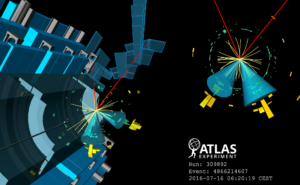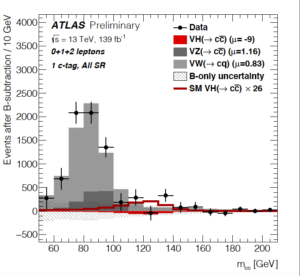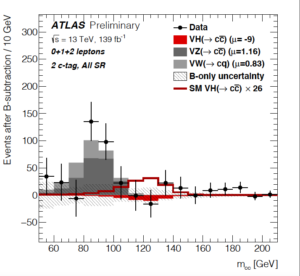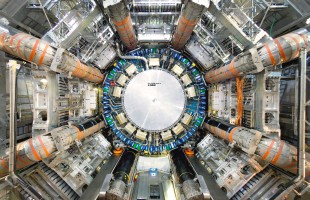The Higgs particle, discovered in 2012, theoretically gives matter particles their mass, but experimentally this has so far only been proven for the very heaviest quarks. With a new analysis, the ATLAS experiment is now starting to gain insight into coupling with a lighter quark, the charm particle.
At the LHCP2021 conference today, it will be announced that that coupling cannot be more than 8.5 times larger than the value predicted in the Standard Model. “This is the first direct limit for higgs to charm quarks that has been measured by an experiment,” says Nikhef physicist Tristan Du Pree. “Basically, we’re showing that there can’t be giant deviations from the Standard Model. We would have seen those by now.”

Recently, Du Pree’s analysis team opened the champagne at the first comparison of the measurements with the predictions, when it turned out that the analyses work well and a direct estimate of the Higgs coupling was possible. Now the result is also going public, through the largest conference for LHC physics LHCP2021.
Key to understanding the Higgs boson and its role in the Standard Model is its interaction with matter particles. Quarks and leptons exist in three generations. Only of the heaviest third generation of matter particles (tau-lepton and the top and bottom quarks), the influence of the Higgs particle has been truly measured so far.
In theory, the grip of the higgs on matter particles moves neatly in line with their mass. But it could also turn out differently. The only way to find out what nature does is by studying particle collisions in which higgs particles are created, which then quickly fall apart.
The new study looked directly, for the first time, at how the higgs affects second-generation matter particles, specifically the charm quark. The theory predicts how often a higgs particle decays into two charm quarks, which produce so-called jets of energy and particles.

With the current margin of error, this turns out to be at least a hundred times smaller than the coupling of the higgs boson to the heaviest quark, the top quark. This is in line with the theory of the Higgs mechanism.
At the same time, Du Pree and his team were able to show that the measurements do show for the first time the predicted formation of such W and Z bosons. This is a good check on the analyses. “W and Z we already know from the last century. But the measurement shows that our technique also works very well at the LHC proton collider,” says Nikhef PhD student Marko Stamenkovic in a Nikhef PAPERCLIP video. He will receive his PhD on the new analyses later this year.
A video on the results from ATLAS can be found here.


